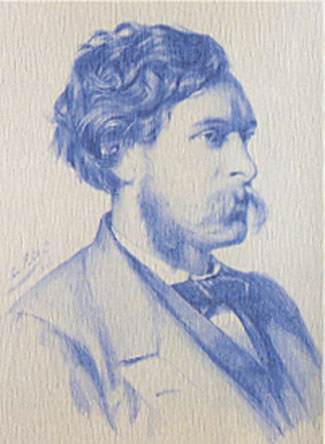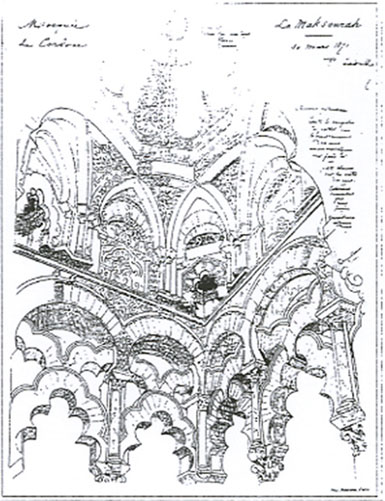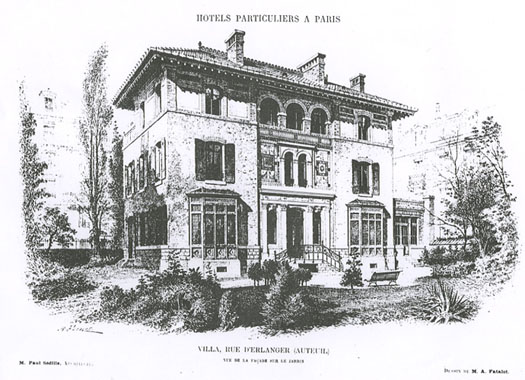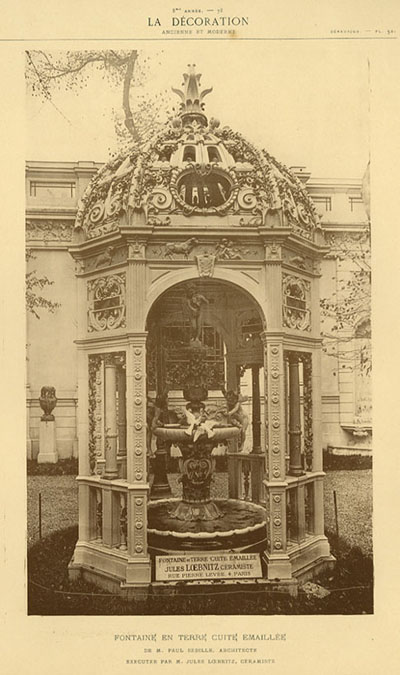Architecture ceramic : Paul Sédille and Jules Loebnitz
Download PDFThe Pichenot-Loebnitz factory was founded in 1833 by Jules Loebnitz’ forefather M. Pichenot. In 1841, M. Pichenot began making large-sized uncrackable earthenware plates for fireplace mantel inserts and other uses, which he successfully presented at a fair in 1844. To avoid crackling in the enamel, he had invented a process that modified the composition of the raw materials of the body instead of the enamel. Breaking away from the traditional white enameling, the Pichenot-Loebnitz factory was the first to produce decorative architectural tiles in 1849 starting with the earthenware panels painted by Devers for the Saint-Leu-Taverny church.
In 1857, Jules Loebnitz succeeded his forefather, and became the director of the company. His father, born in Îéna and naturalized French in 1824, had married in to the Pichenot family.
An artist as much as a businessman Jules Loebnitz inherited the company and for his first major job passionately collaborated with architect Félix Duban on the restoration of the Blois Castle, recreating the antique tiles of the mantelpieces. He then worked with the most prominent architects of his times, Eugène Viollet-le-Duc, Laval, Charles Garnier, Just Lisch and Paul Sédille. A friendship was born in 1867 between Paul Sédille, the architect of the Printemps department stores and the Basilica of Bois-Chenu in Domrémy-la-Pucelle, and Jules Loebnitz that would lead to a tight long lasting professional, artistic and intellectual collaboration. This was an important meeting between the theorist of polychrome architecture and the man who had pushed French ceramic art considerably forward, allowing for large enameled earthenware plates decorated with very bright and long lasting vitrifiable colors, to quote the Brongniart’s words. Many architectural projects were born from the collaboration of Sédille and Loebnitz: World’s fair pavilions, apartment buildings, villas, hotels and monuments.
A reporter covering the 1878 World’s fair described the monumental door of the Fine Arts Pavilion in the following words: “Nothing is more beautiful than the monumental door to the Fine Arts entrance made by Mr. Loebnitz and designed by Mr. Sédille [ … ] everything about it is grandiose, with an elegant and crafty décor, an enamel that can withstand our cold wet winters [ …]” Indeed the portico of the Fine Arts section designed by Sédille included some earthenware elements that measured as much as 47 inches square, made by Loebnitz. This collaboration was rewarded with a medal.
In 1884 at the Decorative Arts Central Union exhibit, Paul Sédille created the entry door adorned with a shield bearing the emblem of the Central Union and a decor inspired by Luca della Robbia, with two reclining female figures modeled by the sculptor André Allar that symbolize Spring and Fall. As he stood admiring the two panels he had made [and for which he had already received the Medal of Honor in the Amsterdam Fair in 1882]: “on the level of ceramics, I (modestly) believe these are masterpieces. In all the exhibits I have visited, I have never seen anything equivalent” (written in August 25, 1884).
Jules Loebnitz commissioned Sédille to renovate his workshop 4 rue de la Pierre-Levée in Paris between 1880 and 1884. The façade was adorned with large ceramic panels drawn by Lévy, a Prix de Rome recipient. In 1883, Sédille asked his ceramist friend to create the enameled earthenware sign plates for the new Le Printemps department store to go with mosaics he had gotten from a Venetian workshop.
“You will need to carefully marry the ceramics with the other materials and specially associate the powerful colors of your enamels harmoniously with the range of colors.” was the advice Paul Sédille gave to Jules Loebnitz in preparation for the World’s Fair of 1889 in Paris. This is how his letter ended:
« Finally I hope that together we will see the generalization of our common dream, of a decoration that is authentic, colorful and everlasting by the grace of earth and enamels emerging from the fire in an inalterable state.”
During this exhibit, as member of the jury, Loebnitz presented an “exhibit of earthenware applied to architecture”, an “elegant portal adorned with enameled tiles and terra cotta. The center piece was a monumental brick mantel, adorned with enameled ornamentation and under the arch two groups of life size terra cotta natural color figures; architecture by Mr. Paul Sédille, figures by André Allar”. The exhibit of 1889 was the height of the golden age for iron and ceramics.
The common dream of Sédille and Loebnitz was expressed in the polychrome architecture of the former and made possible by architectural ceramics of the latter. Loebnitz used unbreakable earthenware to create genuine architectural elements, which were inherent parts of the construction, resistant to thermal shock and acting as a perfect foundation for traditional tin-glazed enamels. This gave birth to architectural ceramics.
With more and more commissions, Loebnitz assisted by his son Jules-Alphonse since 1880, produced among other projects the decors of the Champs de Mars and Le Havre train stations, the theater in Monte-Carlo, the tiles of the cupola of the Joan of Arc monument in Rouen and Jules Loebnitz triumphed again in many industrial and decorative exhibitions. When he died in 1895, Sédille built a tomb in the Père Lachaise cemetery in Paris for his friend.
The company continued excelling with Jules-Alphonse, Jules’s successor. For example in the 1900 Fair, he presented a fountain surrounded by a kiosk - the fruits of his own collaboration with Paul Sédille.
The depression of 1929 and the intense competition of industrial ceramics forced the company to close its doors in 1935.
Bibliography
Découvrez notre site dédié à la manufacture Loebnitz
Discover our website dedicated to the Loebnitz Factory













